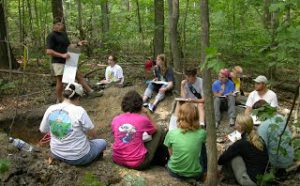Ecosystem Science in the Rockies
Co-listed as EARTH450/ENVIRON450 (Summer)
The Rocky Mountains are an ideal setting to study the relationships between climate, geology and ecology; all are intertwined to create landscape-level patterns of terrestrial and aquatic ecosystems that are readily observable across this climatically and geologically diverse region. The course explores the principles of ecosystem science using field projects in the Rocky Mountains. The unique and diverse geological history and climate of this region controls the occurrence of terrestrial and aquatic ecosystems, and the plants and animals of which they are composed. We will develop and use an understanding of geological and metrological processes to understand the distribution and function of grasslands, forests, and alpine ecosystems in the Rocky Mountains. The course is designed for majors in geological sciences, natural resources and environmental science to gain field-based knowledge and experience of Rocky Mountain geology and ecology. It is also designed for students majoring in other areas who have a general interest in this subject matter. This course will be team taught by professors from several different disciplines. The course is taught at Camp Davis in Jackson, Wyoming.
Most days will begin with a lecture on fundamental concepts and an explanation of an exercise designed to illustrate these principles in the field. Thus, we will spend the majority of our time in the field making observations, collecting data, and discussing the information we have obtained. Given the field orientation of the course and its location, there are several ways in which you should prepare yourself to gain the most from this experience. Students with general course work in geology and ecology will be well prepared to take on the intellectual challenges of this course. In addition, those in good physical condition will be well prepared to take on the physical challenges of this course. Realize that we will travel by foot when doing field work, and on several occasions we will hike from relatively low elevations (ca. 6000 ft) to the alpine ecosystems which lie over 10,000 ft.
Students are expected to have completed and introductory geology (EARTH 116, 118, 119 or 120) course and either General Ecology (ENVIRON 281) or and introductory Environmental Science course (EARTH 201, 202 or 284). Information about applying to Camp Davis and general requirements can be found at http://lsa.umich.edu/earth/camp-davis.html. Students outside of the University of Michigan are also welcome to apply.
Soil Ecology
Co-listed as NRE 430 – ENVIRON 430 – EEB 489 (Fall)
Soils are a central component of terrestrial ecosystems. Major emphasis for this course is placed on physical, chemical, and biological properties and their relationships to plant growth and ecosystem processes. Understanding of these soil components is developed using a combination of lectures, field and laboratory exercises and individual research. The function of soils in forested ecosystems is the primary focus; however, examples are drawn from a wide range of terrestrial ecosystems.
- How the interactions of landform, topography, climate, and biota over time lead to the patterns of soil development and the distribution of soil types that we observe within the landscape;
- How physical, chemical, and biological properties of forest soils affect water and nutrient availability to plants and, ultimately, ecosystem productivity; and
- How nutrients are cycled within forest ecosystems and how these processes are influenced by land management practices.
In the field portion of the course, we will sample and describe soils of four forest ecosystems and observe first-hand how differences in landform, topography, climate, and biota influence soil development. In the laboratory we will analyze our soil samples for a number of physical, chemical, and biological properties. Using these data in conjunction with field data, each student will select two of the four ecosystems for detailed comparison in a term paper. Although we will focus our attention on local forest ecosystems of Michigan, skills learned in this course may be broadly applied within a variety of terrestrial ecosystem types in other geographic regions.
Students are expected to have a background in chemistry and biology. In particular, a working knowledge of chemical equilibria, ionic solution chemistry, pH, and oxidation-reduction reactions is highly recommended. Students without such background should consult with the instructor before enrolling. Also useful (although not required) is familiarity with biochemistry, plant physiology, microbiology, geology, and local flora. You will find it very helpful if you have had, or are currently enrolled in, Woody Plants (ENVIRON 337). The lectures and laboratory exercises in Soil Properties and Processes have been designed to complement Forest Ecology (ENVIRON 435), and we highly recommend that you enroll in these courses concurrently.




